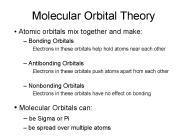Orbitals PowerPoint PPT Presentations
All Time
Recommended
1, 2, and 3 correspond to the major energy levels (main shells) ... pz. dxy. dxz. Which type of orbital can't exist? 1px. 2px. 2s. 3dxy. 10 ...
| PowerPoint PPT presentation | free to download
Hybrid orbitals . . . Used to describe the shapes of molecules. Used to describe properties of various types of bonds holding atoms together. Used to discuss how ...
| PowerPoint PPT presentation | free to view
Molecular Orbitals Chapter 9 Molecular Orbital model This model examines unpaired electrons, bond energies and excited state electrons. Examine the H2 molecule.
| PowerPoint PPT presentation | free to view
Atomic Orbitals And Quantum Numbers Quantum Numbers A series of 4 numbers (and/or letters) that specify the properties of an electron in its orbit The first 3 come ...
| PowerPoint PPT presentation | free to download
Molecular Orbitals An overview MO Theory Robert Mullikan won the Nobel Prize in 1966 for developing this theory. This theory describes the electrons in orbitals ...
| PowerPoint PPT presentation | free to download
Molecular Orbital Theory The anti-bonding orbital is sometimes given the notation u, where the u stands for ungerade, or asymmetric with respect to a center of ...
| PowerPoint PPT presentation | free to download
An orbital is defined as the part of the atom where electrons are most likely to ... The arrangement of the electrons among the various orbitals of an atom is called ...
| PowerPoint PPT presentation | free to view
Orbitals and Bonding Ionic vs. Covalent
| PowerPoint PPT presentation | free to view
COVALENT BONDING: ORBITALS HYBRIDIZATION (9.1) HYBRIDIZATION Consider methane,CH4 C has 4 valence electrons 1s2 2s2 2p2 This suggests that there might be two kinds of ...
| PowerPoint PPT presentation | free to view
Third Year Organic Chemistry Course CHM3A2 Frontier Molecular Orbitals and Pericyclic Reactions - Prof Jon A Preece - School of Chemistry University of Birmingham
| PowerPoint PPT presentation | free to download
Chapter 9 Covalent Bonding: orbitals Topics Hybridization and the localized electron model The molecular orbital model Bonding in homonuclear diatomic molecules ...
| PowerPoint PPT presentation | free to download
Molecular Orbitals Chapter 5 Molecular Orbital Theory Molecular orbital theory uses the methods of group theory to describe bonding. Symmetry and relative energies ...
| PowerPoint PPT presentation | free to download
An atom has as many electrons as it has protons to give it a zero overall charge. ... Neon with its ten electrons fill the 1s orbital, the 2s orbital and the 2p ...
| PowerPoint PPT presentation | free to download
We used the hydrogenic orbitals as the energy states for electrons in all atoms. ... thing now: we are going to construct molecular orbitals out of hydrogenic atomic ...
| PowerPoint PPT presentation | free to view
Molecular Orbital Theory. Combination of atomic orbitals on different atoms forms molecular orbitals (MO's) ... Waves that describe atomic orbitals have both ...
| PowerPoint PPT presentation | free to view
Chapter 10 Hybridization and Molecular Orbitals Atomic Orbitals Don t Work to explain some molecular geometry. In methane, CH4 , the shape s tetrahedral.
| PowerPoint PPT presentation | free to view
Energy Levels and Orbitals An investigation into electrons and their location and behavior within the atom Learning Targets: Describe the process of excitation and ...
| PowerPoint PPT presentation | free to view
orbitals are inside an atom, but it. is not known precisely where the ... an orbital is the shape of the. space where there is a high. probability of finding electrons ...
| PowerPoint PPT presentation | free to view
Molecular Geometry and Hybrid Orbitals H-C-H bond angle 90o +
| PowerPoint PPT presentation | free to view
- Science Honors Program - Computer Modeling and Visualization in Chemistry Atoms, Electrons, Chemical Bonding, and Orbitals * * As the energy of the MOs increases ...
| PowerPoint PPT presentation | free to download
Many times, the final sublevel is not completely filled with electrons ... Notice how one electron goes into each orbital of a sublevel before they pair up. ...
| PowerPoint PPT presentation | free to download
Chapter 9 Covalent Bonding: Orbitals Hybridization The mixing of atomic orbitals to form special orbitals for bonding. The atoms are responding as needed to give the ...
| PowerPoint PPT presentation | free to view
10.7 The Hydrogen Orbitals In the Wave Mechanical model of the atom an orbital represents the space around the nucleus occupied by an electron.
| PowerPoint PPT presentation | free to download
Chapter 9 Covalent Bonding: Orbitals Zumdahl & Zumdahl M. Todd Tippetts, Ph.D. * Chem FAQ: Use hybridization to describe molecular geometries. Use VSEPR theory to ...
| PowerPoint PPT presentation | free to view
Introductory concepts: Atomic and molecular orbitals Jon Goss Outline Atomic orbitals (AOs) Linear combinations (LCAO): Hybrids Molecular orbitals (MOs) One-electron ...
| PowerPoint PPT presentation | free to download
In this section we will consider the orbitals used for bonding in covalent ... Regelation-application of pressure to liquefy ice (application: ice skating) due ...
| PowerPoint PPT presentation | free to view
Optimization of Numerical Atomic Orbitals. Eduardo Anglada. Siesta ... Very efficient but they lack a systematic for ... the enthalpy in the ...
| PowerPoint PPT presentation | free to view
Does the C atom bond to the H atoms using these orbitals (one s and three ... set of five dsp3 orbitals can combine to have the trigonal bipyramidal structure. ...
| PowerPoint PPT presentation | free to view
Placing electrons in d orbitals (strong vs weak field) Strong field Weak field Strong field Weak field d1 d2 Strong field Weak field
| PowerPoint PPT presentation | free to download
Chemical Bonding II: Molecular Geometry and Hybridization of Atomic Orbitals Chapter 10 Valence shell electron pair repulsion (VSEPR) model: Predicting Molecular ...
| PowerPoint PPT presentation | free to view
Valence Bond Theory: Overlap of Atomic Orbitals s bond - overlap of s orbitals H-H + s bond - overlap of s orbital and p orbital H-F 1s 1s F: 1 s bond - head/head
| PowerPoint PPT presentation | free to download
Chemical Bonding II: Molecular Geometry and Hybridization of Atomic Orbitals Chapter 9 Valence shell electron pair repulsion (VSEPR) model: Predicting Molecular ...
| PowerPoint PPT presentation | free to download
Orbital Diagrams Use individual orbitals Give subshell arrangement Each orbital takes one electron before any other orbital in the same subshell can receive a second ...
| PowerPoint PPT presentation | free to download
Cutaway diagrams showing the spherical shape of S orbitals. The 2p orbitals. Radial probability 'Accurate' 'Stylized' Combined area ...
| PowerPoint PPT presentation | free to view
What is a 'hydrogenic' orbital or state? The hydrogen atom electron's energy ... We use the hydrogenic orbitals (1s, 2s 2p, 3s 3p 3d, etc.) to describe the ...
| PowerPoint PPT presentation | free to view
A single sp3 orbital, each with single electron. A single sp2 orbital, each ... geometry around O is trigonal planar. requires 3 equivalent orbitals from the O ...
| PowerPoint PPT presentation | free to download
Chapter 10 Bonding and Molecular Structure: Orbital Hybridization and Molecular Orbitals Two Theories of Bonding MOLECULAR ORBITAL THEORY Robert Mullikan (1896 ...
| PowerPoint PPT presentation | free to view
Lecture 13 Bond Polarity, Molecular Orbitals. Dipole Moment, m. m ... Calculate the Bond Order: BO = no. of bonding. electrons. no. of antibonding. electrons ...
| PowerPoint PPT presentation | free to view
Figure 1-1. Shape of various electron orbitals. From Brownlow (1996). Figure 1-2. Variation of energy levels for the various subshells as a function of atomic number.
| PowerPoint PPT presentation | free to download
Number of hybrid orbitals is equal to number of pure atomic orbitals used in the ... Delocalized molecular orbitals are not confined between two adjacent bonding ...
| PowerPoint PPT presentation | free to view
* * * * * * * * * * * * * * * * * Section 9.14: Molecular Orbital Theory (cont.) Molecular Orbital (MO) ... the bond order for the H2 molecule is: A bond order: 1.
| PowerPoint PPT presentation | free to view
Valence shell electron pair repulsion (VSEPR) model: Predict the geometry of the molecule from ... Mix at least 2 nonequivalent atomic orbitals (e.g. s and p) ...
| PowerPoint PPT presentation | free to view
X-Ray Spectroscopy of Salt Solutions: Perturbations of the Unoccupied Orbitals of Water ... Condensed Phase and Interfacial Molecular Science (Dr. Greg Feichter) ...
| PowerPoint PPT presentation | free to download
Density functional theory (DFT) and the concepts of the augmented-plane-wave plus local orbitals (APW+lo) method Karlheinz Schwarz Institute of Materials Chemistry
| PowerPoint PPT presentation | free to download
Forbidden. Zone! Energy, E. 1023 ns. Atomic Orbitals. 3 x 1023 np ... Small forbidden zone between filled band and conduction band. Filled band of. 2 x 1023 sp3 ...
| PowerPoint PPT presentation | free to download
Satellite-Ground Conjunctions with CANOPUS Instrumentation. Orbit designed to maximise apogee CANOPUS/CGSM ground conjunctions. ...
| PowerPoint PPT presentation | free to view
Molecular Orbital Theory. Atomic orbitals mix together and make: Bonding Orbitals ... Molecular Orbitals can: be Sigma or Pi. be spread over multiple atoms ...
| PowerPoint PPT presentation | free to download
Molecular Orbital Theory. Atomic orbitals mix together and make: Bonding Orbitals ... Use handout to fill in and. determine bond orders ...
| PowerPoint PPT presentation | free to download
Spinful Fermions: flat-band itinerant ferromagnetism ... Flat-band itinerant FM in p-orbitals. 34. Percolation picture for flat band FM. ...
| PowerPoint PPT presentation | free to download
Molecular Orbital (MO) Theory. Diagram of molecular energy ... Bonding in s-block homonuclear diatomic molecules. Energy. Li2. Be2. Combinations for p-orbitals ...
| PowerPoint PPT presentation | free to view
ORBITAL HYBRIDIZATION: The question of shape! We need next to examine the relationship between: isolated atoms (with valence e s in s,p, and d orbitals
| PowerPoint PPT presentation | free to view
Molecular Orbital Theory or when electrons don t like sitting between atoms! Molecular Orbital Theory In the molecular orbital model, orbitals on individual atoms ...
| PowerPoint PPT presentation | free to download
Molecular Orbital Theory The goal of molecular orbital theory is to describe molecules in a similar way to how we describe atoms, that is, in terms of orbitals ...
| PowerPoint PPT presentation | free to download
Potential energy curves are important. Ground ... Linus Carl Pauling (1901-1994) Nobel prizes: 1954, 1962. Many electron w.f. in terms of atomic orbitals (A.O. ...
| PowerPoint PPT presentation | free to view
Electrons in these orbitals help hold atoms near each other. Antibonding ... Excited states, colors, glowing things. Eyesight. Structures of all the molecules. ...
| PowerPoint PPT presentation | free to download
Molecular Orbital (MO) Theory. orbitals from different atoms combine to ... no rotation. This leads to 'isomerism' in molecules. with double bonds: Ex: C2H2Cl2 ...
| PowerPoint PPT presentation | free to view
























































